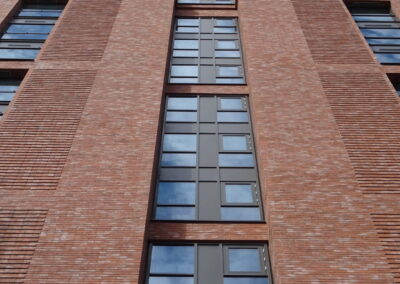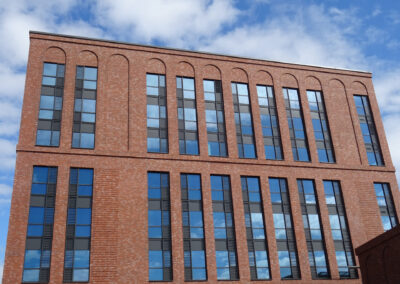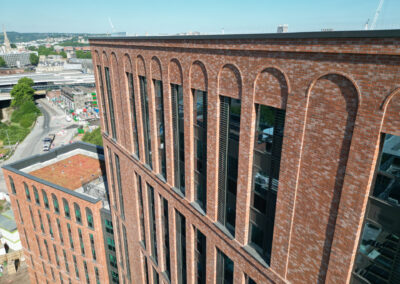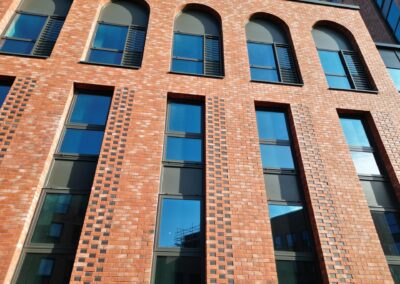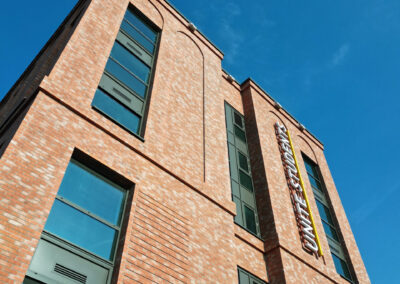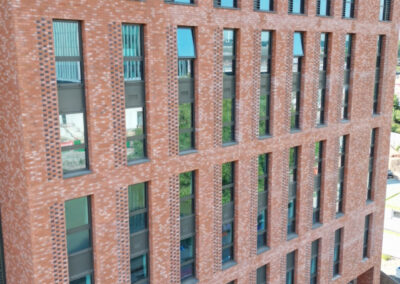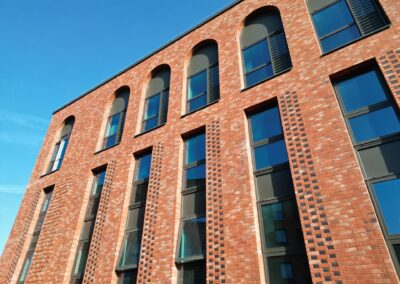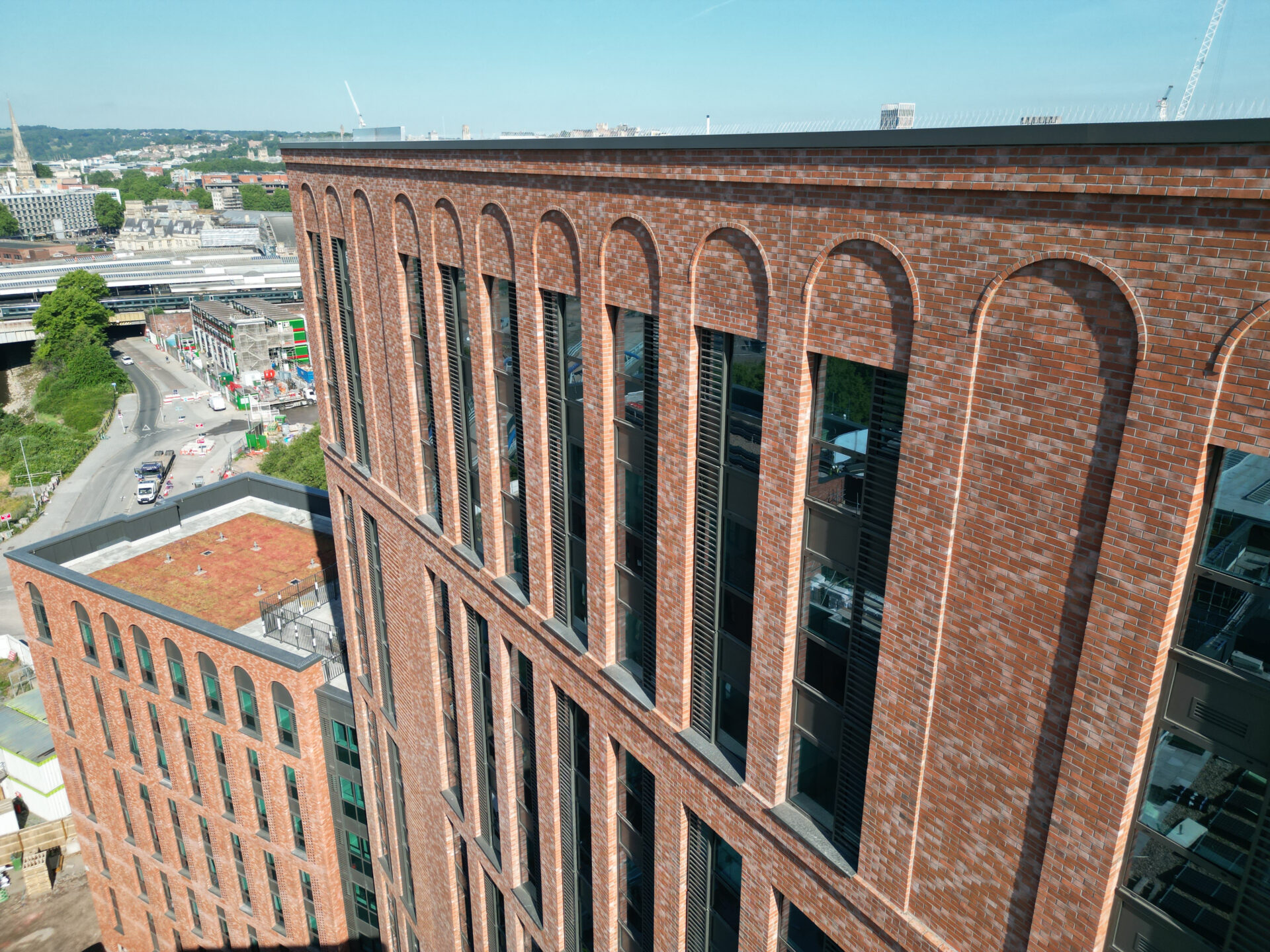INCA Case Study: Avon Point, Bristol
Avon Point, Bristol
Project Type: New Build
Building Type: High Rise, Residential
Architect: Hadfield Cawkwell Davidson
System Designer: Aliva UK
Installer: PIC Construction Group
System & Finish: AlivaBrick
U-Value Before: N/A
U-Value After: 0.12 – 0.19 W/m²K
AlivaBrick a showcase in brick slip versatility and Bristol Byzantine architectural detailing
Avon Point is a £75million 623-bed new-build Purpose Built Student Accommodation development, in Feeder Road, Bristol, in the heart of one of the UK’s largest regeneration areas.
Unite Students is the largest provider of student accommodation in the UK. Its Avon Point development has been designed to support the next generation of students with high-quality living, social and study spaces, in line with Unite’s mission, to create vibrant communities for students as their Home for Success.
Avon Point is a 5 storey, part 7, part 8 and part 14 storey development for which Aliva UK is proud to have provided a customised External Wall Insulation brick slip facade system with several impressive archways and accent details to create architectural flair with a brickwork aesthetic utilising Modern Methods of Construction (MMC).
It is a fully bespoke system that pays homage to the Bristol Byzantine architectural style and the city’s industrial heritage, while meeting all elements of the architectural brief without compromise.
Bristol Byzantine architecture: For the judges’ context, this is a variety of Byzantine Revival architecture, popular in Bristol from c.1850-1880. It has influences from Byzantine and Moorish architecture and was applied mainly to industrial buildings e.g. warehouses and factories. The style is characterised by a robust and simple outline, materials with character and coloured polychrome brickwork including black, archways and upper floors unified through either horizontal or vertical grouping of window openings.
AlivaBrick for Avon Point: The scale and versatility of Aliva UK’s AlivaBrick slip system has been demonstrated in a showcase of accent detailing on Avon Point that pays homage to this Bristol Byzantine style yet equally represents contemporary residential design.
The system features 7,000sqm of EWI AlivaBrick, which demonstrates the architectural impact it can have used at scale to make a statement impression on a city skyline.
The system includes 15mm red multi slips and 9mm black slips for accent detailing/shadow effects, with two thicknesses of mineral wool insulation used.
The system has realised a series of grand sweeping brick slip archways crowned with soldier bonds, that take the eye from ground to sky. They sit alongside a mix of intricate laddering details with shadow effect created from black slips, recesses, step outs and projecting banding serving as a subtle complement to the larger detailing. These all blend together to create architectural intrigue and flair alongside an aesthetic that evokes the city’s urban heritage.
The AlivaBrick system is A1 fire rated and Kiwa UK certified. It has been developed to ensure the highest fire classification has been achieved based on testing to standard EN 13501-1:2019.
Jordan Smith, Architect at Hadfield Cawkwell Davidson, said:
“The AlivaBrick EWI system played a significant role in enabling the delivery of a richly articulated and contextually grounded façade.
“The architectural design draws on the strong industrial heritage of the area, particularly through the use of brickwork arches, a motif seen across Bristol’s historic fabric. These were reinterpreted in a contemporary manner, with a double-height arched colonnade at ground level and arched window heads at upper levels. These elements contribute to a carefully layered façade that balances visual rhythm, civic presence and contextual reference.
“The system offered the flexibility and precision required to achieve complex details such as recessed arches, laddered coursing, and areas of brick projection.
“In addition to its visual performance, the system contributed significantly to the project’s sustainability goals. Its lightweight structure reduced embodied carbon while enhancing the thermal performance of the external envelope.”
Installation
INCA member PIC Construction Group was the installation contractor. The system was installed over a lightweight steel frame with a 12mm cement particle board to the outer-face. The lightweight studs were infilled with mineral wool and finished internally with a Vapour Control membrane and 2 layers of gypsum plasterboard.
The Aliva system was directly fixed using specified mechanical fixings, with the insulation layer installed board-by-board, including a cementitious levelling layer to the rear of the insulation. This allowed any tolerances within the frame to be adjusted, and a vertically level face provided for subsequent layers.
The required number of fixings were installed, using engineered wind calculations. Once the boards were installed reinforced cement basecoat layers were applied. The first, allowed the insertion of a reinforcing mesh, lapped to create a monolithic covering across the entire façade. This mesh was also mechanically fixed with stainless steel fixings and washers to comply with fire requirements and to provide additional robust mechanical fix to the system. Once the final layer of basecoat was applied and smoothed the basecoat was allowed to cure.
Once cured, the cement-based bedding mortar was applied to the surface and the 9mm and 15mm clay slips installed by embedding the slips into the bedding mortar. Full embedment was achieved, ensuring the clay slips had full surface area contact. This continued to achieve the brick façade. The slips were then pointed with a robust cement-based Aliva pointing grout and struck to achieve the final finish.
U-Values: The project had several detail interfaces, however the U-Value ranges achieved were between 0.12-0.19W/m2k, inputted into the final thermal calculations for the entire building.
Embodied carbon: Avon Point’s operational energy levels have been reduced through a fabric-first approach prioritising building elements including walls to create energy-efficient buildings. This is where the thermal benefits of Aliva’s EWI brick slip system has contributed towards Avon Point’s embodied carbon savings, 7,300tCO2e over the building’s lifecycle.
Sustainability: AlivaBrick reduced material and weight on the project plus slip production requires approximately 85% less energy than conventional brick, adding to the NZC contribution.
What the client said:
“The scale and location of this flagship project dictated the need for an innovative approach to be taken to its construction, not least the material selection and methods of working. This made the decision to use the AlivaBrick system a reasonably straightforward one; especially when considering the programme gains against traditional brickwork construction.
“The site’s operational energy levels have been reduced through a fabric-first approach. This is where the thermal benefits of Aliva’s EWI system has helped contribute towards Avon Point’s embodied carbon savings, 7,300 tCO2e over the lifecycle of the building.
“At Unite we have set ambitious NZC targets. The AlivaBrick slip system has contributed to us meeting our businesses expectations for delivering both sustainable and attractive buildings.
“The flair that can be realised with brick slips is evident on Avon Point, detailing that blends together beautifully to create architectural intrigue on the eye.”
Kate Donovan, Development Project Manager, Unite Students
The AlivaBrick EWI system played a significant role in enabling the delivery of a richly articulated and contextually grounded facade. The system offered the flexibility and precision required to achieve complex details such as recessed arches, laddered coursing, and areas of brick projection.


